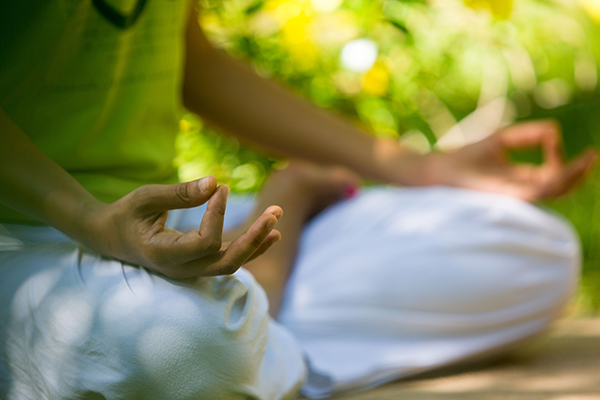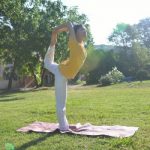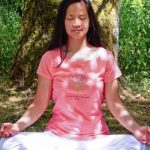 The Basics of Meditation
The Basics of Meditation
by Swami Vishnudevananda
Hear the Silence, see the Silence, smell, taste, and touch the Silence. That Silence is God. That Silence is the peace that passeth all understanding. Close your eyes and become one with that Silence.
Much has been said and written about meditation, yet it takes years to properly understand its nature. It cannot be taught, just as sleep cannot be taught. One may have a king-sized posture-pedic mattress, an air-conditioned room, and the absence of all disturbances, but sleep may not come. Sleep itself is not in anyone’s hands. One falls into it. In the same way, meditation comes by itself. To still the mind and enter into the silence requires daily practice. Yet there are certain steps that can be taken to establish a foundation and ensure success. Before beginning, have a proper environment and attitude. Your place of meditation, schedule, physical health and mental state should reflect a readiness to turn inward. Many difficult obstacles are removed by creating a setting which is conducive to meditation.
 GUIDE TO MEDITATION
GUIDE TO MEDITATION
The following are practical points regarding the basic techniques and stages of meditation. They are primarily intended for the beginner, although even the most experienced meditator will find a review of them useful.
- Regularity of time, place and practice are the most important elements of the practice to consider. Regularity conditions the mind to slow down its activities with a minimum of delay. It is difficult to focus the mind, which wants to jump about as soon as you sit for concentration. Just as a conditioned reflex is a response to established external stimuli, so the mind will settle down more quickly when time and place are established.
- The most effective times are dawn and dusk when the atmosphere is charged with special spiritual force. The preferred time is known as brahmamuhurta in Sanskrit, the hours between four and six a.m. In these quiet hours after sleep, the mind is clear and unruffled by activities of the day. Refreshed and free of worldly concerns, it can be moulded more easily; concentration will come without effort. If it is not feasible to sit for meditation at this time, choose an hour when you are not involved with daily activities and the mind is apt to be calm. Regularity is the most important consideration.
- Try to have a separate room for meditation. If this is impossible, screen off a portion of a room; do not allow others to enter it. The area should be used only for meditation and should be kept free from other vibrations and associations. Incense should be burned morning and evening. The focal point of the room should be a picture or image of the chosen deity or inspirational figure, with the meditation mat placed before it. As meditation is repeated, the powerful vibrations set up will be lodged in the room. In six months peace and purity of the atmosphere will be felt; it will have a magnetic aura. In times of stress you can sit in the room, do repetition of mantra for half an hour, and experience comfort and relief.
- When sitting, face north or east in order to take advantage of favourable magnetic vibrations. Sit in a comfortable steady posture with spine and neck held erect but not tense. This helps to steady the mind and encourages concentration. The psychic current must be able to travel unimpeded from the base of spine to the top of the head. It is not necessary to place the legs in padmasana, the classic lotus posture. Any comfortable cross-legged posture provides a firm base for the body. It makes a triangular path for the flow of energy, which must be contained rather than dispersed in all directions. Metabolism, brain waves and breathing will slow down as concentration deepens.
- Before beginning, command the mind to be quiet for a specific length of time. Forget the past, present and future.
- Consciously regulate the breath. Begin with five minutes of deep abdominal breathing. Inhale for three seconds and exhale for three seconds. Then slow the breath to an imperceptible rate.
- Keep the breathing rhythmic. Regulation of the breath also regulates the flow of prana, the vital energy.
- Allow the mind to wander at first. It will jump around, but will eventually become concentrated along with the concentration of prana.
- Do not force the mind to be still. This will set into motion additional brain waves, hindering meditation. If the mind persists in wandering, simply disassociate from it, and watch it, objectively, as though you were watching a movie. It will gradually slow down.
- Select a focal point on which the mind may rest. For those who are predominantly intellectual, the object of focus should be visualised in the space between the eyebrows. For those who are more devotional, it should be visualised in the heart plexus in the middle of the chest. Never change this focal point.
- Focus on a neutral or uplifting object or symbol, holding the image at the place of concentration. If using a mantra, repeat it mentally, and coordinate the repetition with the breathing. If you do not have a personal mantra, OM may be used. Although mental repetition is stronger, the mantra may be repeated aloud if one becomes drowsy. Never change the mantra.
- Repetition will lead to pure thought, in which sound vibration merges with thought vibration, and there is no awareness of meaning. Vocal repetition progresses through mental repetition to telepathic language, and from there to pure thought. This is a subtle state of transcendental bliss with duality, where there remains awareness of subject and object.
- With practice, duality disappears and samadhi, the superconscious state, is reached. Do not become impatient, as this takes a long time.
- In samadhi one rests in a state of bliss in which the knower, knowledge and known become One. This is the superconscious state reached by mystics of all faiths and persuasions.
- Begin the practice of meditation with twenty minute periods and increase to one hour.































